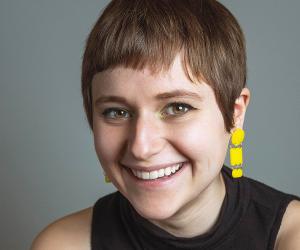If we were to try to bag and tag a pervasive trend in the design world right now, we’d find clusters within futurism, sustainability, empathy and above all: human-centred design. Twelve young, up-and-coming designers have been curated for Design Indaba Conference 2019. While we’ve outlined just five of the speakers below, keep an eye locked on this space for more.
Kordae Jatafa Henry
Creative Director and Artist Kordae Henry imagines an Afro Futuristic utopia in Earth Mother, Sky Father: 2030. The mind-bending sci-fi feature premiered on Nowness. An experimental film that takes viewers to Congo in the year 2030, it's set in a time when the wealth of the Central African nation stays within its borders rather than flowing out. It’s a future Wakanda-like world where Congo’s unrefined rare earth minerals become part of the nation’s culture - revered, respected and treasured.
The artist tells the story through interpretive dance and Afrocentric visuals. Henry, born as a Jamaican-British-American, explains the inspiration for the project in a New York Times piece: "The piece exposed the truth behind the mineral trade and its industry in Africa, explaining how minerals were being exploited from the Congo, refined overseas, and developed into the batteries in our electronic devices" explains the Los Angeles-based director.
"That day I was searching through my photographs of my time in Nairobi, where I first was aware how cellphones became one of the largest ways to distribute money through the country. I began to see a future not just for the country, but for the continent."
Henry’s work forms part of a movement to give Africa and Africa’s past, present and future a new lens through which to interpret itself. At Design Indaba, a number of alumni have displayed the importance of this exploration. This includes Director Sunu Gonera, Architect David Adjaye and Fashion Designer Amna Elshandaweely.
Freyja Sewell
The benefits of meditation are well known. But what if you could monitor, learn and calm your mind to enhance your mental well-being?
In the age of constant connectivity, Brighton University graduate and designer Freyja Sewell created Mind Mirror to function as a medical training device.
Strapped to the user’s head, the Mind Mirror allows people to understand what is happening to their own brain during meditation. It helps people understand when they are in Flow State, a desirable mental state achieved through meditation.

It’s made up of three elements: The neural lace consisting of 32 sensors on the head monitors the activity on the brain.
A data system that represents feedback in a soothing visual and audio format.
And lastly, the flat-pack Faraday Pod provides protection from stray electrical signals (Faraday waves) to the extremely sensitive sensors in the Neural Lace, improving accuracy.
Her work, which includes traditional furniture and cutting edge technologies, is a fascinating look into Japanese design culture, a core source of inspiration in both her personal and professional life.
Nicole Nomsa Moyo
South African designer Nicole Nomsa Moyo created Ukubutha as a way for disenfranchised communities to empower themselves without depending on government assistance.
Service delivery after the weight of the Apartheid government is still almost non-existent in impoverished places in South Africa. Ukubutha, which means ‘to gather’ proposes a waste-to-energy design with socially driven architecture.
The sanitation hub aims to empower and collectively solve the underlying needs of access to adequate sanitation, a safe source of water and the production of energy.
An independently built water, sanitation and energy hub, Ukubutha provides materials, system mechanisms and spatial qualities based on a response to social and environmental awareness.
The design is aimed at assisting the relief of service delivery backlogs for the government, municipalities and communities in, but not limited to Pretoria, South Africa.
The sanitation hub would provide on-site fabrication of recycling and resource recovery. Ukubutha is about creating sustainable environmental spaces for collective engagement and wellbeing.
Moyo conceptualised the project at Carleton University in Canada. In the interview below, Moyo talks about how she envisions service delivery in the future.
Pascale Theron
Design Academy Eindhoven graduate Pascale Theron creates work that compels viewers to learn about and question history, culture and memory.
Born in Johannesburg, South Africa, Theron looked to the history of the once popular ostrich feather for inspiration.
The ostrich feather was once a highly valued commodity during the 19th Century, as Victorian and Edwardian women sought out big plumes to decorate their flamboyant hats. Since then, the feather has fallen from grace and now its main use is removing dust or in tacky carnival costumes.
“I aim to enhance the value of the ostrich feather, a very specialised product coming from the 150 year old ostrich feather industry in Oudtshoorn, South Africa,” says Theron.
“I hope to go beyond the aesthetic and decorative and rather return it to its former glory in a more integrated and practical way, within modern society where big feathered hats are no longer stylish.”
Theron’s work speaks to a popular and necessary design trend that asks us to question the products we use, how those products are made and how we can design in a way that is waste-free and biodegradable.
Shaina Garfield
Burial rituals vary from culture to culture. But for many of us, it means putting a dead body in a coffin and then in the ground. It’s a symbolic return to the elements and a big part of saying goodbye.
But this practice has come at a price: there just isn’t space to keep putting people into the Earth. Pratt graduate Shaina Garfield is offering a greener alternative to the traditional burial.
Leaves is a type of burial rope and cloth made with biodegradable materials. The coffin’s rope is dyed and embedded with spores. Once the body is buried, fungus grows to speed up the decomposition.
Most importantly, the fungus eats the plethora of toxins in our bodies so only nutrients go into the soil. A tree is then planted above the burial site so the cemetery becomes a beacon of new life.
Here's Garfield on the process and meaning behind her design:











